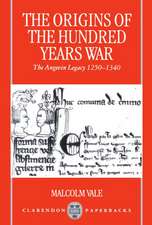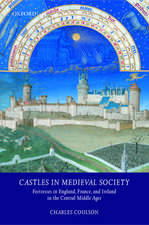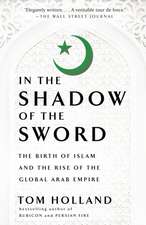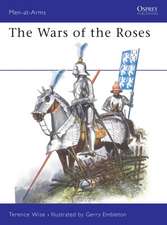The Last Apocalypse [With Photograph Inserts]
Autor Jr. Reston, Jamesen Limba Engleză Mixed media product – 31 ian 1999
Cataclysmic changes and widespread upheaval marked the decades around A.D. 1000, much as change continues to rock our world today. The old order was crumbling anti confusing new ideas were gaining hold. Random violence end the bloody victories by the Vikings, Magyars, and Moors convinced many Europeans the apocalypse was upon them. And then, the tide turned -- the Viking gods were dethroned, the shamans of the Magyars massacred, the glorious Moorish caliphate disintegrated, and, finally, the sign of the cross held sway from Spain to Russia.
James Reston, Jr.'s enthralling saga of how the Christian kingdoms converted, Conquered, and slaughtered their way to dominance the turn of the last millennium brings to life unforgettable historical characters who embodied the struggle for the soul of Europe.
Preț: 113.56 lei
Nou
21.73€ • 22.74$ • 18.09£
Carte disponibilă
Livrare economică 10-24 martie
Specificații
ISBN-10: 0385483368
Pagini: 336
Dimensiuni: 130 x 203 x 20 mm
Greutate: 0.27 kg
Ediția:Anchor Bks Trad.
Editura: Anchor Books
Extras
As he approached Norway's shore, Olaf possessed no fine sense of what Christianity meant, especially its gentler side. But he must have had some sense of the calendar. The world was approaching the thousandth year after Christ's birth, and with it, Christ the King would come a second time. There would be a final climactic battle between the forces of good and evil. It was not hard for Olaf to view Earl Hacon as the Antichrist. The earl was the murderer of his father, the rapist of Norway's daughters, and the high priest of heathenism. Nor was it hard to imagine Hacon's soldiers as the forces of Gog and Magog.
If there was any imagery in the Christian bible to which a Viking warrior, raised in the heathen tradition, could relate, it was the magical language of Revelation. For beasts and monsters, giants and trolls were the most familiar of notions.
"And as I stood upon the sand of the sea and saw a beast rise up out of the sea, having seven heads and ten horns, and upon his horns ten crowns, and upon his heads the name of blasphemy," reads Revelation 13 about the first beast. "And the beast which I saw was like unto a leopard, and his feet were as the feet of a bear, and his mouth as the mouth of a lion; and the dragon gave him his power, and his meat, and his great authority."
How different was that from the apocalypse of the heathens? For in the villages and temples of Olaf's upbringing, in Norway and in Russia, there had been talk of Ragnarok, that terrible end-time when the world sinks into moral chaos, into anxiety and greed, into an intoxication with gold, when brothers kill brothers and incest is rampant. In this wolf's age, Odinn becomes an agent of violent death and is himself killed violently, when war breaks out between the Vanir and the Aesir, and the gods mete out punishment to oath breakers, murderers, rapists.
In the day of Ragnarok, the wolf will swallow the sun. Another wolf will seize the moon. The earth and the mountains will tremble so violently that trees will be uprooted, mountains will crash down. The sun will go black. The earth will sink into the sea. And the heavens will lose their stars.
In this final battle between the good and the evil gods, all will die. There are no winners, only losers. Into this chaos and conflagration, Inn riki, the Mighty One, will ride triumphantly. And with him the world will be renewed and purified, and afterward, only innocent gods will rule.
When Olaf Trygvesson finally approached the nose of Norway, he touched land offshore on Moster Island, pitched a tent, and held a great mass. Afterward, he considered his situation. Should he make a big noise in the land or try to take Earl Hacon by surprise? He decided on the latter course and moved quietly up the coast to the mouth of the Trondheim fjord. On its southern point, he sent a few spies inland, and they came back with excellent news. Earl Hacon was indeed in the area, and he was up to his old escapades. He had just tried to seize the wife of a respectable farmer and had been turned back by a rabble of the farmer's friends. Now the earl was feasting at a place called Medalhus and could not leave well enough alone. He had sent his slaves to seize the beautiful wife of another freeholder named Orm. But Orm was no more compliant. He delayed the earl's messengers with food and drink while he sent a call to arms, and the farmers were gathering in great anger, ready to kill Earl Hacon. Olaf could scarcely have wished for better intelligence.
Moving stealthily into the fjord with his five ships, he spotted the earl's three ships, lying at anchor near Vigg. The earl's handsome son was watching over the royal fleet, and when he saw Olaf's sea stallions bearing down on him, he weighed anchor and tried to get away. But Olaf caught up and hurled a tiller at the young man, striking him on the head and killing him instantly. Soon after, Olaf made contact with the rebellious peasants, who by this time had blocked off the roads and were ready to pounce on the lecherous earl.
But Earl Hacon was already on the fly. His own troops having deserted him, he took refuge in the area with his mistress, an estimable woman of great power named Thora. Her cozy relationship with the earl was well known and it could be expected that Olaf and his farmers would come to look for the fugitive there first. So Thora had her slave dig a hole beneath her pigsty. Logs were placed over the hole, and manure on top of the logs. With his slave named Kark, the earl crawled into the poke, hoping to wait out the trouble, if he could stand the smell.
As expected, Olaf soon turned up. His rebels searched the house inside and out, and when they could not find the earl, Olaf climbed up onto a large rock next to the pigsty and gave a speech to his troops, promising great reward and honor to anyone who could find the earl and kill him. Earl Hacon and his slave Kark heard the speech through the seeping timbers, and the earl turned on his slave suspiciously.
"Why are you so pale?" he whispered. "Do you have a mind to betray me?"
"By no means, master," Kark replied.
"Remember this," the earl said. "We were born on the same night. The time between our deaths will be short."
After Olaf went away and the night came, the earl and his slave tried to sleep. But Kark had a bad dream, and at his moans, Earl Hacon woke him up. "What on earth is the matter with you?"
"I had a bad dream," the slave replied. "I was at Lade, and Olaf Trygvesson was laying a gold ring around my neck."
"It will be a red ring Olaf lays around your neck if he catches you," the earl snapped. "Take care. From me you will enjoy good things, so do not betray me."
They tried to go back to sleep, but each was now so suspicious of the other, they tried to keep an eye open. Eventually, the earl dropped off, and he too slept so fitfully that he cried out in his sleep. Horror-struck, Kark woke up with such a fright that he pulled a knife from his belt and plunged it into Earl Hacon's throat, killing him. Then thinking of the reward and honor that Olaf Trygvesson had promised from the rock, Kark cut off the earl's head, took it to Lade, and presented it proudly to Olaf.
Olaf thanked him, gave him a gold ring, and then had him beheaded.
In 996 A.D., a national assembly was held, and Olaf Trygvesson was proclaimed the king of all Norway. One by one, the petty earls and chiefs of the country paid him homage, even the leaders of the Uplands and the Vik, who before had been in league with Svein Forkbeard, the king of Denmark. In his first winter and summer as king, Olaf traveled along his rocky coast to consolidate his realm, as the heirs of Earl Hacon, full of vengeance, fled to Sweden.
Toward the end of the first millennium, Norway was a sparsely peopled kingdom. It was ruled by a motley group of petty lords and cultivated by self-reliant freeholders who farmed and fished along the coast and the riverbanks and took orders from no man. The total population of the country did not exceed fifty thousand people, and it was spread along the rocky, crenellated coastline. The trading towns like Kaupang on the western point of the Oslofjord or Trondheim and Lade in the north had no more than about five hundred people, even in high season. Few ventured inland, into the dense forests toward the keel of mountains that separated Norway from Sweden. The greatest concentration of people was in the Vik, that region encompassing Oslo's fjord which was the domain of Olaf's martyred father, King Trygve. It was there that Olaf began his crusade to Christianize his land.
In the Vik, during the summer and fall of 996 A.D., he had easy sailing. Many of his relatives were still powerful, and the supporters of his father were legion. In the preceding decades when the Christian king of Denmark Harald Bluetooth held sway over the area, many had converted to Christianity. But when the Thor-loving Earl Hacon took over, the converted reverted, and once again, the gods of Aesir were transcendent. King Olaf burned with messianic fire, however, and the days of choice were over. Olaf gathered his relatives together and deputized them as Christ's captains.
"I shall make you great and mighty men for doing this work," he told them. "All Norway will be Christian or die."
The east and west shores of the Oslofjord acceded immediately to the king's demand, but in the northern part of the Vik the resistance was greater. He treated the holdouts without mercy, killing some, mutilating others, and banishing the rest. By the end of the year, between his sword and his axe, he had claimed all of the Vik for Christ and dared anyone to claim otherwise.
In the early spring of 997 A.D., he moved west into Hordaland with a great force, to the Agder along the tip of Norway's nose, and into Rogaland. The farther west he moved, the stiffer and more organized became the opposition. Local chiefs conspired to plan a defense of the old traditions, conferring the dubious honor upon three of the region's most eloquent talkers to speak out against the king and his new religion when a general assembly was held. Legend holds that the three had sudden attacks of discombobulation. The first and most eloquent was seized with a cough and shortness of breath and could not utter a word; the second became so confused that the audience laughed him down; and the third developed a sore throat. Some supernatural force was clearly at work. Thereafter, the region voted for Christianity and the people were baptized.
The king moved on, north to the fjord country, the south and north More and Raumsdal. He was a model of consistency. Sometimes he began whimsically, challenging a heathen to a swimming race or a shooting contest, and to the winner's faith goes the loser. Once he is said to have shot a chess piece off the head of a boy to impress the child's agnostic uncle. Generally, however, the challenge was more direct: Christianize or fight. Few were ready for the latter.
And so they did what he asked. They pretended to convert and wept battle tears at their loss. The heathen gods were proclaimed to be evil spirits: anyone who trafficked in such evil was to be banished, especially the sorcerers. Once, at a place on the river Gota, he gathered all the wizards and the troll-wise high priests of the region in a longhouse for a great feast, then closed the doors and burnt the building to the ground. But their leader escaped through the smoke hole, and when he was caught, King Olaf marooned him and his fellow incorrigibles on a rock far offshore at low tide. Afterward, the rock was called the Skerry of the Warlocks.
When he came to Trondheim, the lair of the late Earl Hacon, he took more extreme measures, burning heathen temples and desecrating heathen idols. At one temple, he found a gold ring of Earl Hacon, hung it on the door of the pagan temple, and when the crowd gathered, he torched the place. This caused anger in the fjord, and again, the local chiefs rose against him, sending out the war arrow through the region as a message to prepare for battle. Faced with this unrest, King Olaf went away to the Vik for the winter, but returned the following summer with a larger army and thirty ships, weighing anchor in the river Nid. Inviting the local chiefs to a fine feast, as an apparent gesture of peace, he indicated his willingness to attend a heathen sacrifice.
At the feast the guests got quite drunk on Viking ale. The following morning, King Olaf attended a mass and then gathered the hungover chiefs together. "It has been agreed between us that we would meet and make a great sacrifice," the king said. "If I am to return to making heathen sacrifices, then I will make the greatest sacrifice of all. I will sacrifice men, not slaves. I propose to take the greatest men only and offer them to the gods." And he named the eleven most prominent leaders of the opposition. When the horrified farmers howled in protest, he took the eleven hostage instead, until everyone was baptized. Finally, he set the eminent men free only when their sons and brothers were swapped for their prominent fathers.
In nearby Trondheim, King Olaf employed another method. Again at the assembly of the local farmers, he appeared open to attending a heathen ritual. "We want, king, that you should offer sacrifice, as other kings before you have done," said the leader, whose name was Iron Beard. The king agreed readily and the crowd went to the local temple. Once the door was closed, Olaf raised his golden axe, struck the image of Thor and ransacked the niches of the other gods, and then killed old Iron Beard. After the survivors agreed to be baptized, King Olaf took Iron Beard's comely daughter as his wife.
As the king moved still farther north, even as far as the Lofoton Islands, the population of potential converts grew sparser and more obstreperous. None was more obstinate than a rich farmer and devout heathen named Raud the Strong, who was the chief of the region, had a large company of Laplanders at his disposal, and commanded a formidable long ship, larger than the king's flagship, with a gilded dragon head on its prow and an upturned serpent's tail in its stern. When Raud heard that the king was coming with his bitter message, Raud mobilized his force, and a fierce sea battle was fought...with predictable results.
Raud, however, escaped and took refuge in his island hideout in the Saltenfjord. The entrance to the fjord was protected by a narrow throat through which the tidal water gushed in torrents, and only the most skilled sailor could navigate it. For more than a week, King Olaf lay offshore, waiting for the wind to calm and the high seas to slacken, trying to figure out when to make a run for it. The problem was greater, we are told, because Raud was expert in witchcraft and had placed a hex on the king. Countermeasures were called for, and so King Olaf summoned his bishop, who laid his holy robes on the stem of the king's ship, sprinkled holy water over the ship, read the gospels, and then gave his blessing to proceed. By some miracle, it is said, the Christian ships passed through the narrow passageway, the water curling gently around the keels, while a few paces away the waves raged so furiously that the nearby mountains were obscured.
Once in the fjord, the royal men quickly apprehended Raud and brought him to the king, who ordered the chief to accept baptism.
"I will not take your property from you, but instead will be your friend," said Olaf sweetly, "if you make yourself worthy to be so."
Raud declined and even made fun of Christ and the Christian God. This enraged Olaf, and he declared that Raud would die "the worst of deaths." The blasphemer was bound to a wooden beam, his mouth was forced open with a wooden pin, and the king's henchmen tried to force an adder down his throat. But Raud's breath came from the pits of hell, and the adder recoiled at the first whiff. So the king took a horn, placed it in Raud's mouth, stuffed the reluctant adder in again, and put a hot iron to the snake's tail. The treatment of Raud was a powerful lesson, and the region, feeling the heat of Olaf's poker, quickly came over to Christ.
By 999 A.D. Olaf Trygvesson, as Christ's supreme hatchet man, had conquered all of Norway for Christianity.
![The Last Apocalypse [With Photograph Inserts] de Jr. Reston, James](https://i1.books-express.ro/be/9780385483360/the-last-apocalypse-with-photograph-inserts.jpg)














